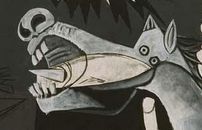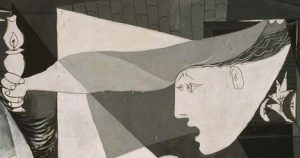Guernica is an artwork created by Pablo Ruiz Picasso which was initially created to express the horror of the Spanish Civil War (1936-1939) but, the passing of time, has made it become into the best masterpiece to express the horror and the brutality of the War.
Strolling around Madrid, nearby Atocha station, an important museum dedicated to contemporary art, Museo Nacional Centro de Arte Reina Sofía can be found. It is worldwide known for hosting a masterpiece with international recognition, the best painting which needs no words to express the pain and tragedy caused by the saddest period of our recent history, the Spanish Civil War. This is an artwork that can revive this period to anyone. We are talking about Guernica by the artist from Málaga Pablo Ruiz Picasso.
Everyday, thousands of visitors come to contemplate this huge work (3x7m) which helps us to immerse ourselves in a world of horror just by visiting the room 206 of the Museum.

Pablo Picasso. Guernica (1937) Museo Nacional Centro de Arte Reina Sofía collection.
The work was an order of the government of the Second Spanish Republic during the period of the Civil War in 1937. The work commissioned to Picasso would be exhibited in the Pavilion dedicated to Spain at the International Exhibition in Paris of this same year. The air of the artwork was to use the art to spread the horror that Spanish society was living during those years of war.
It seems that Picasso was going through a inspiration crisis, he had not advanced in the project for months, but he suddenly found a theme for his work when receiving the news of the bombings on the 26th of April of 1937 by the German Condor Legion on the Basque village of Guernica. The Third Reich had ordered the bombing to help the troops of the dictator Francisco Franco to win the War. The air raid lasted about 4 hours and it killed more than 120 people and the entire destruction of the city. Inspired by it and despite its large dimensions, Picasso ended his artwork in just 7 weeks.
The commander of this legion was Colonel Wolfram von Richthofen, cousin of the famous I World War aviator Manfred von Richthofen, known as the Red Baron, who would also recognize the cruelty of the bombing.
It is said that in the middle of the creative process in his studio in Paris, a group of Gestapo officials knocked on Picasso’s door and got stunned with the Guernica. Staring at the magnificent work and the horror that it spred, they asked him: Have you done THAT? To that question, Picasso answered, full of hate: “You did THAT, Nazis”.
Picasso never wanted to give his own explanation about the artwork and so, many theories have arisen trying to explain the symbolism of the painting and the intentions of the artist.
What can be assured is that the painting symbolizes the barbarism and terror produced by the war. It became the emblem of the harrowing conflicts of European society of the early twentieth century as well as the premonition of the suffering caused by the Second World War.
Concerning the symbolism of this cubist work, we find several elements worthy of analysis. The work is divided into two groups: the one of the animals and the one of the human beings. At the center of the composition horse stands trampling on a warrior. This is a symbol of the European totalitarian regimes and the repression exerted by their dictators – Franco, Hitler and Mussolini. The horse is a clear allusion to death, as its nose and teeth forms a skull.

Detail of the skull in Guernica.
The warrior holds in his right hand a broken sword, a symbol of defeat. In it, a hidden flower can also be found. It represents the renewal of life, which would be a neccesary but tough and not so clear period for the victims.

Detail of the flower and sword in Guernica
The mythological figure of the Minotour, half bull half human, perfectly reflects the struggle between the human and the bestial side of the war.
Regarding the people depicted in the painting, the protagonism of one women stands out. In spite Picasso was married to one woman and expecting a child from another one, When Picasso painted Guernica, he was maintaining a relationship with the French artist Dora Maar, whose face appears holding a candle in the painting, reflecting with this the little light that illuminated the life of Picasso in that tragic moment. As an allusion to his sentimental situation, they also appear in the picture.

Alleged portrait of Dora Maar in Guernica
Dora photographed the entire creation process leaving by doing it a very important document for the history of Art.

Pablo Ruiz Picasso painting Guernica
The photographs published by the press of the bombing over Guernica and its brutallity were the inspiration of Picasso and the reason for the lack of color in his work. It is a symbol of the darkness of that terrible period of the Spanish history.

Ruins after the bombing of Guernica
From the date of his commission, in 1937 to nowadays, 80 years have passed. However, due to the II World War outbrake in 1939, Picasso decided to take his painting to the MoMA Museum of New York to protect it from the war. He also took another decision. As in Spain the Civil War had been won by the troops of the Dictator Franco, Picasso decided that the painting won’t be moved to Spain until the democratic freedoms were restored in the country. This didn’t happened until the death of Franco in 1975. That is why Picasso didn’t see his work exhibited in any Spanish museum. He died in 1973. The artwork finally arrived in Spain in 1981, to be exhibited in the Cason del Buen Retiro as it belonged to the Museo Nacional del Prado, and it was finally taken to the Renia Sofia Museum in 1992.
Thus, the images of the suffering reflected in the Guernica express a metaphor of the damage suffered by the painting itself due to the transfers produced along the period comprise between the date of its creation and its final installation in the Museum. It was necessary to roll it up and unroll it 90 times so that it could be shown in 30 cities of Europe and the United States before coming to Spain to finally rest.
To celebrate the 80th anniversary of the creation of this work, the Reina Sofía Museum pays tribute to it through an exhibition entitled “Pity and Terror. Picasso’s Path to Guernica” which can be visited until the 4th September.
The director of the art gallery, Manuel-Borja Villel, described the work as the first antimonument of history, because the objective of its creation was not to be admired but to make feel the repulsion that the modern wars cause with their horror and deaths. This exhibition aims to gather the greatest documentation that exist about this work, to go in depth in the knowledge of the painting and the influence of the war on the artist’s work.
Therefore, from Leaf Madrid we recommend you take advantage of the opportunity offered by the Reina Sofía Museum to understand its most important artwork, to see how the war influenced the artist in his future artworks and to become breathless when staring at the the masterpiece that better shows the horror of the war.
If you want to find more remains of the Civil War and more stories about it along Madrid… do not hesitate to sign up for one of Our Free Walking Tour Madrid
